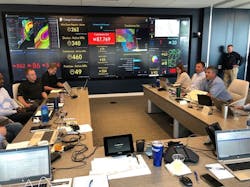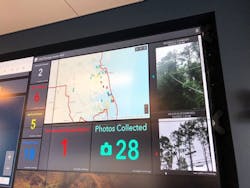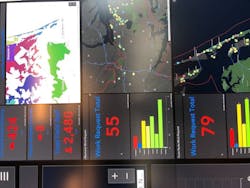Dominion Energy is heralded for its state-of-the-art Emergency Preparedness Center in Richmond, Virginia. The response headquarters was completed in 2019 and its small, but integral staff of meteorologists and emergency preparedness center specialists typically devise strategic storm restoration plans that are scalable for minor to catastrophic events. With the coronavirus pandemic, the critical resource has played a key role in planning for a new type of emergency.
"In the case of severe weather forecast that could impact operations, we must have a plan in place for getting the lights on and ensuring we are ready when our customers need us the most," said Alan Bradshaw, director of distribution operations center and emergency preparedness. "Our critical services and the essential tasks our employees perform require the same attention to safety and operational sustainability no matter the emergency."
The typically storm-response oriented organization took on a central role at the onslaught of the pandemic to spearhead operational response amid the strict health guidelines. The team's mindset mirrored its same customer-focused mission during a storm.
The Emergency Preparedness Center, along with the company’s safety organization, coordinated everything from how materials were pulled and staged, to how crews maintained vehicle sanitation. Like most utilities, Dominion Energy has a pandemic response plan, but it needed to be customized to address the specific challenges of the coronavirus. In this case, setting up clear lines of communication and enabling a team approach to coordinate a myriad of departmental efforts at a very dynamic time was important to ensure the best possible outcome.
"Things were very fluid and fast-paced in the March through April timeframe," Bradshaw said. "There was no getting our feet under us, we were running as fast as we could to ensure our employees were able to not only be there for our customers but also be as safe as possible."
And of course, being able to safely and efficiently respond to customer outages caused by storm events is critical — to an even greater degree during a pandemic. Dominion Energy’s meteorologists provide more than a weather forecast. They translate the weather into potential operational impact on the grid. Once severe weather causes impact, the regional operation centers and local offices begin the process of pinpointing the damage that caused the outages and begin a regimented and frequently trained restoration process. During the pandemic, they also identified where trouble would most likely hit so that additional personal protective equipment (PPE) could be deployed efficiently. Masks, hand sanitizers, and surface cleaners were premium items in the early months, and everyone played a role preparing to stay ahead.
During large restoration events, the Emergency Preparedness Center converts to a System Storm Center, which is managed through an Incident Command Structure (ICS). In addition to daily assigned roles, almost everyone in Dominion Energy’s Power Delivery Group also has a storm role. The ICS allows for quick and efficient transition into storm mode and activation of the System Storm Center. Three large video walls are the centerpieces of the Storm Center, displaying multiple dashboards that provide situational awareness for restoration efforts that may span Dominion Energy’s service territory. The information on these dashboards range from weather, outage counts, damage assessment photos, bucket truck counts, traffic conditions, lodging progress, and local news coverage.
Bradshaw noted that the pandemic created the need to use these dashboards to also track health information, CDC and state health guidance, and COVID-19 heat maps showing case counts by city and county.
These technological advancements prove useful during most weather events. However, in spring 2020, plans had to be revised.
Just a few weeks after Virginia declared a coronavirus emergency, a major storm impacted a significant portion of Dominion Energy Virginia’s service territory on April 13, 2020. The storm knocked out power for an estimated 200,000 customers. In most major restoration events, it would be all hands on deck at the System Storm Center, but during the peak of the pandemic, a new directive was put in place in order to respond to the crisis within a crisis.
For the Dominion Energy team, that meant thinking outside the box. First, a majority of storm center staff was decentralized within company facilities or in remote work locations. This proved quite difficult. As in any crisis, communication is key. Messages can easily get lost in translation and there is no room for error when customers need crews to restore their power and normalcy to their lives.
Although decisions are normally made collaboratively in the System Storm Center, the tried and true organization and processes were no longer in play. However, the objective always remained to get the lights back on while keeping crews on the frontlines safe.
"In the April storm, we learned how difficult it can be to establish and sustain communications when we aren’t all in the same room. It wasn’t always perfect. But if we were going to be successful, we had to find a way to communicate," said Bradshaw. "It’s certainly been a focus area for us as we continue to refine our restoration plans to adapt to the COVID-19 constraints."
That communication extended to the safety of the crews dispatched to repair downed power lines. Although restoration is business as usual for them, the coronavirus pandemic heightened safety protocols.
First, social distancing mandates eliminated the ability for line crews to travel in the same vehicle. Second, lodging was limited to single occupancy rooms and crews were assigned to stay on separate floors. Finally, buffet-style lunches and dinners were substituted with boxed meals and curbside service.
Despite changes to the restoration plan, crews remarkably restored power within 36 hours from the peak of the outages. Bradshaw said lessons were learned, but the basics of the business remain.
"We learned a lot from this event, but the pandemic hasn’t changed what it takes to replace a pole, pull up a wire, and restore power. Our job is, and always has been, to ensure the health and safety of our employees and customers and to keep the lights on."



